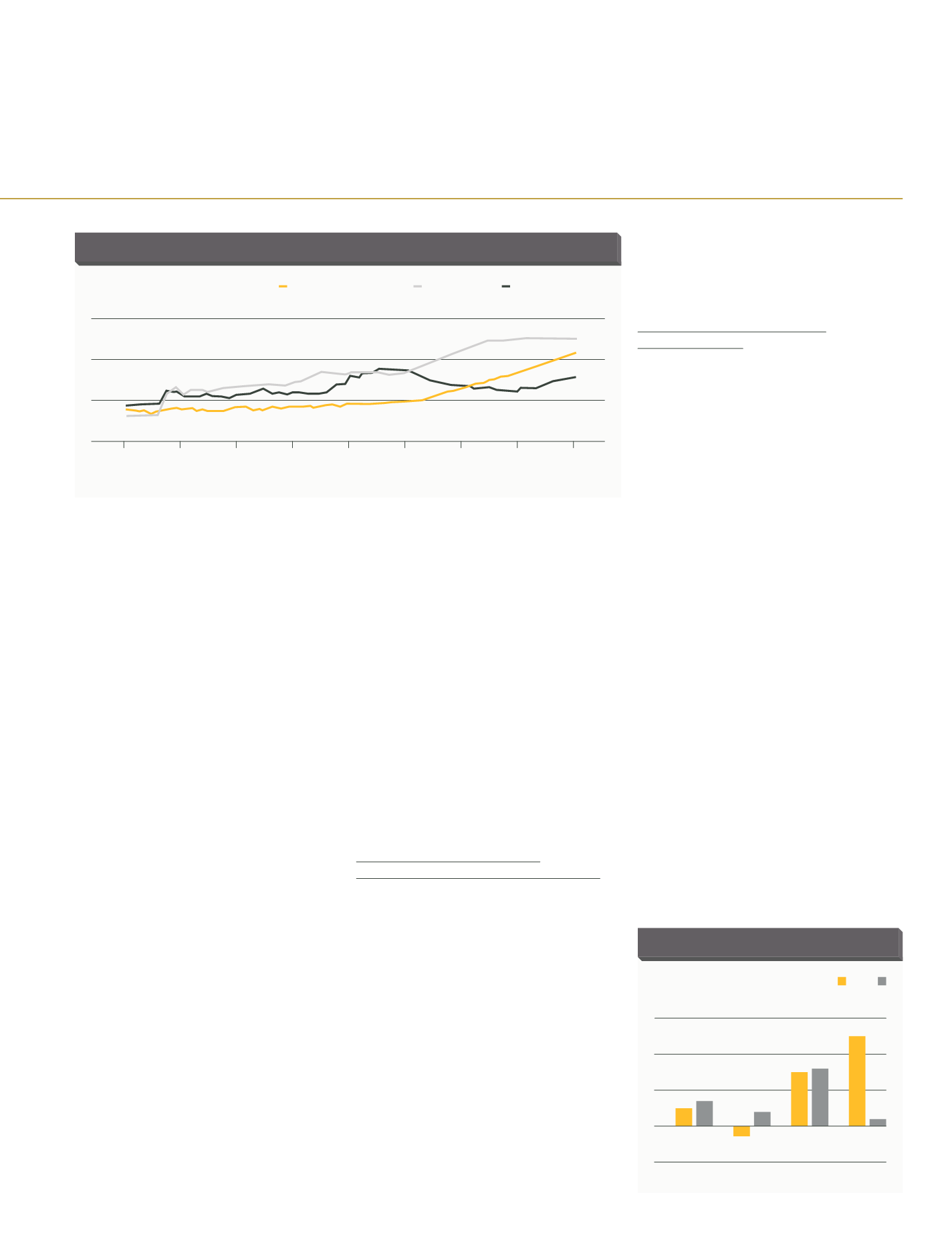
29
PART I: INTRODUCTION
The lackluster performance of the Chinese
economy in 2015 urged the decision-makers
to take more policy measures for boosting the
economy. In this respect, People’s Bank of China
(PBOC) devaluated the renminbi (yuan) to bring
momentum to the exports and put a brake on
capital outflow, which has accelerated in recent
months. On the other hand, November 2015
talks concerning the inclusion of yuan in the
SDR (Special Drawing Rights) basket, defined
as IMF’s international reserve asset, were
positive, and it was decided to add the yuan
to the SDR basket by January 2016. Finally, the
PBOC announced six interest rate reductions
since 2014 to boost the economy. The one-year
borrowing rate was lowered to 4.35% and the
one-year deposit rate to 1.5%. In parallel, a 50
basis point reduction was made to the required
reserve in October 2015.
THE WORLD’S ECONOMIES HAVE
CONTINUED TO GRAPPLE WITH DEFLATION
Developed and developing economies alike
continued to grapple with deflation in the
year 2015. In the US economy, where the exit
from expansionary monetary policies started
in 2014, the 2015 inflation rate reached 0.7%,
way below the Fed’s target of 2%. The inflation
rate in the Euro Zone closed the year at 0.4%,
in a drop of 0.2% percentage points from the
previous year. As such, the inflation outlook
was more positive in 2015, despite ongoing
deflationary worries. In Japan, too, in spite of
the ongoing expansionary policies, concerns
about the low inflation rate were not over in
2015. Indeed, the inflation dropped sharply over
the previous year to hit 0.2% in 2015.
OIL PRICES CONTINUED TO DROP
SHARPLY IN 2015
After their significant drop in 2014, oil prices
continued to head downwards in 2015. Oil
prices reached a peak of USD 66.6 per barrel,
before falling to as low as USD 36.5 per barrel
in december. Factors underlying this drop were
the excess supply on the global level, as well
as OPEC’s announcement at its 25 November
meeting that it would not cut oil supply. The
downward pressure on oil prices grew stronger
following the OPEC decision, prompting the
closure of numerous wells and towers in the
USA for not being profitable at that price level.
The drop in oil prices had a positive effect
on importing countries such as Turkey, even
as petroleum exporters such as Russia were
badly affected. Supply side continue due to the
ongoing impact of the OPEC decision, as well
as Iran’s statement that it could even increase
production in case of additional demand in
2016. However, the global growth expectation
for 2016 is higher than that for 2015, which
might mean that the supply-related downward
pressure on oil prices are not going to be
as strong as expected. Furthermore, OPEC’s
announcement that the oil price cannot continue
to drop at this pace and that corrections will be
observed in a year, has led to the expectation
in the markets that the organization could
take a measure against the price fall in the
coming period. As such, in 2016, oil prices could
fluctuate less and hover around USD 35 per
barrel.
In Europe, which has been grappling with low
inflation and high unemployment levels for
many years, the ECB continues its quantitative
easing policy designed to bolster economic
activity. In March 2015, ECB announced its
decision to implement a bond-buying program
of EUR 60 billion per month, to last until
September 2016. During the year, it was
indicated that the program could be extended
and the interest rates could be lowered further.
In its december meeting, the ECB lowered the
deposit rate by 10 basis points, from -0.20% to
-%0.30, and extended the deadline of the bond-
buying program from September 2016 to March
2017. The volume of asset purchases, however,
remained unchanged at EUR 60 billion. In his
speech after the meeting, the ECB President
Mario Draghi suggested that quantitative easing
would continue until the inflation target is
attained and that the bond-buying program
would be diversified with regional bonds.
Japan is also continuing to pursue expansionary
policies to stimulate its economy. The Bank
of Japan (BoJ) declared that it would continue
its expansionary monetary policy until the
inflation rate reaches 2%. On the other hand,
the Japanese government has approved the
2016 budget, which focuses on raising high
tax revenues in order to add impetus to the
economy and reduce the public debt. The
Japanese Prime Minister Shinzo Abe called upon
companies to pay higher wages and boost
capital expenditure so as to overcome deflation.
CENTRAL BANK BALANCE SHEET SIZE
6,000
4,000
2,000
0
600
400
200
0
11.2007
11.2008
11.2009
11.2010
11.2011
11.2012
11.2013
11.2014
11.2015
Japan (trillion yen, right axis)
US (billion dollar)
Euro Area (billion euro)
Source: Bloomberg
Source: IMF
2015
2014
3
2
1
0
-1
USA
Euro Area
China
Japan
INFLATION
(%)
0.5
0.7
0.4
1.5 1.6
2.5
0.2
-0.2


